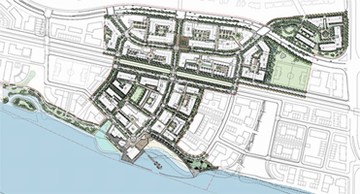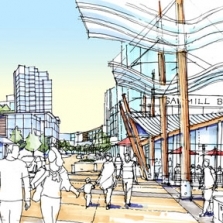Public Realm Plan for Vancouver’s East Fraserlands development wins national honour

East Fraserlands (EFL) is a 130 acre brownfield site along the Fraser River in Vancouver BC. The EFL site, for several decades a lumber mill site, is one of  Vancouver's last large scale neighborhood planning projects. It is being developed and planned as a sustainable neighborhood for the City of Vancouver. The maste rplan is based on the principles of new urbanism and features a well-planned mix of townhomes, low and mid rise apartments and high rise towers.
Vancouver's last large scale neighborhood planning projects. It is being developed and planned as a sustainable neighborhood for the City of Vancouver. The maste rplan is based on the principles of new urbanism and features a well-planned mix of townhomes, low and mid rise apartments and high rise towers.
In 2008, the Phase 1 Rezoning Public Realm Plan was awarded a National Honour by the Canadian Society of Landscape Architects.
 “The judges recognized the comprehensive nature of the document and its commitment to deal with the full spectrum of pressing issues that challenge all municipalities and developers as we strive to plan new high density urban developments that are both liveable and sustainable,” stated Chris Sterry, Prinicpal of PWL Partnership Landscape Architects Inc,
“The judges recognized the comprehensive nature of the document and its commitment to deal with the full spectrum of pressing issues that challenge all municipalities and developers as we strive to plan new high density urban developments that are both liveable and sustainable,” stated Chris Sterry, Prinicpal of PWL Partnership Landscape Architects Inc,
More About East Fraserlands
To read an earlier story about the project that is posted on the Water Bucket website,click on Official Development Plan for East Fraserlands Wins Award of Excellence
The PWL Partnership also collaborated with InterCAD and Kim Stephens to develop the Rainwater Management Plan for East Fraserlands, finalized in June 2008.
“EFL:will showcase a 'design with nature' approach to rainwater management and green infrastructure. Furthermore, the term landscape-basded rainwater system has been coined to describe the rainfall capture strategy for reinstating natural groundwater regimes and supporting community livability outcomes,” reports Brent Tedford, representing Parklane Homes, the developer of East Fraserlands.
“The EFL case study is a case study for an inter-governmental initiative called Beyond the Guidebook. The EFL case study is considered the most rigorous and sophisticated application of the Water Balance Model undertaken to date in British Columbia,” adds Kim Stephens, Program Coordinator for the Water Sustainability Action Plan for British Columbia.
Posted June 2009

